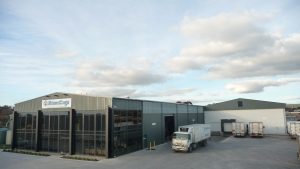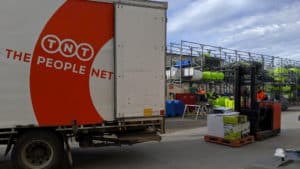Microsoft Dynamics NAV’s great flexibility enables multiple interfaces for FTA Food Solutions and Ward McKenzie
When sister companies FTA Food Solutions and Ward McKenzie partnered with Fenwick Software and Microsoft Dynamics NAV in 2007, they had been hamstrung by a 10-year-old software platform that could not handle major business processes nor deliver the level of automation demanded by rapid growth. “We needed something that would be more configurable than the system we had, a platform that would handle everything and give us one solution for purchasing, sales, inventory and financials,” says FTA IT Manager, Lynne Burgess. “Sybiz was too manual, we needed software that could automate the whole process.”
Lynne Burgess is the great granddaughter of William Ward, who founded the business in 1850. Her sister Helen Ward manages the Ward McKenzie Group. Once NAV was bedded down, the great flexibility of the system was demonstrated as new business demands emerged.
Three interfaces were implemented in quick succession:
- EDI between FTA Food Solutions and major client PFD Foodservices
- An interface with the Cargowise customs system
- Electronic integration with third party logistics supplier VISA Global Logistics Group.
Further initiatives followed:
- EDI with Coles Supermarkets
- An interface with 1-Stop shipping schedules
- Tracking of container dimensions to maximise space for internal warehouse transfers
- Electronic integration with third party logistics supplier Karras Cold Logistics (to be completed mid-2013)
- Scan packing (2013).

EDI with PFD Foodservices speeds ordering and cuts errors
PFD Foodservices is a key account for FTA. Prior to this interface, the volume of orders from PFD required an FTA staff member to spend three or four days a week re-keying faxed orders, handling discrepancies, checking pricing and preparing invoices. This order entry process is now completed in a matter of hours, and more time is invested into managing the customer relationship.
I would recommend Fenwick and NAV, because of the benefit of having a system you can modify. That’s where you spend your money, so you’ve got to be in a position where you can get the return on it. And we have.
Lynne Burgess, IT Manager, FTA Food Group
Ben Beasley, one of the Fenwick Software Consultants who has recently worked closely with both FTA Food Solutions and Ward McKenzie, says the volume of orders was huge and there were a number of data discrepancies between FTA and PFD. Orders would be placed with PFD’s reference code, which didn’t match the item code held in NAV so a significant amount of time was wasted in cross referencing the codes. “When we developed the interface, we used that reference code as the look-up on the item so this is now done instantly,” Ben says.
Purchasers at PFD now raise an order in their own system and transmit it via the web to FTA, where it becomes a sales order. Once the order is confirmed and any adjustments made, it is posted in NAV and an electronic invoice goes to PFD. A final purchase order, including any adjustments, is created at PFD to complete the process. “It’s very much a two way street where they provide an order, and we provide confirmation in the form of an invoice,” Ben says. “It took a while to get it up and running, but once it was working properly there were very few complaints about it.”
Because the electronic links between the two companies are now so smooth, the interface has provided FTA Food Solutions with a strong competitive advantage over other suppliers. FTA is keen to introduce interfaces with other large customers because there are huge advantages for both parties. “You need to have cooperation from the customer side but there really are massive speed and accuracy benefits. The customer knows their orders will be addressed almost instantly, and that they will get feedback within a day,” Lynne says.
Ninety per cent of all PFD orders are now created automatically, and Lynne says the company has saved significant time and money. “The interface has certainly resulted in a reduction in user input, the data is now correct and there are fewer errors,” she says.
Cargowise Interface minimises data input for customs declarations
Prior to the Cargowise interface, FTA Food Solutions would enter a significant amount of data into NAV concerning imported goods and then rekey it into Cargowise. The interface now sends this information straight from NAV to Cargowise, halving the data entry and ensuring much greater accuracy. A significant amount of information is involved, including product specifications, cost, country of origin and final destination, quarantine or inspection details, the duty rate, any applicable free trade agreements, shipping details and the bill of lading. Ninety per cent of this information is stored in NAV.
FTA has slashed the duplication of data and improved its integrity through this interface. Lynne says FTA will now work with Fenwick Software and look to build a bespoke customs module within NAV. This will facilitate new business opportunities, including FTA acting as a customs broker for companies which import goods but would rather outsource the shipping and customs transactions.
We have a good partnership with Fenwick. Ben Beasley has been great. I think the relationship has been very profitable for both of us.
Lynne Burgess, IT Manager
Interface with VISA Global Logistics Group boosts inventory accuracy
FTA Food Solutions’ previous third party logistics supplier in Sydney was unable to electronically integrate with FTA, causing significant problems including major discrepancies with inventory. Manual files were kept, FTA staff were advised via email of stock movements, and a staff member was working full time matching stock levels between FTA and the logistics supplier. The huge volume of orders and the number of discrepancies resulted in very inaccurate inventories which were not fully realised until all stock was moved from the previous supplier to VISA.
FTA wanted to trace all stock movements and maintain a mirror image of inventory held by its third party supplier. VISA offered that service, which was further improved through an interface between the two businesses.
FTA now sends its customers’ sales orders electronically to VISA, and receives a response as soon as the stock is physically picked. If any adjustments are needed, for example if stock has expired and has to be written off, FTA is immediately advised and the stock is automatically adjusted in NAV.
The interface ensures FTA is notified every time stock moves in or out of VISA’s warehouse, and can compare stock movements with its own audit. VISA is also notified of every stock movement at FTA, and the system is validated with regular stocktakes. A similar interface with Karras Cold Logistics will go live in mid-2013.
EDI Integration with major supermarket chains
Both Coles and Woolworths prefer suppliers to use EDI to receive orders and send invoices, and a previously implemented interface enabling Ward McKenzie to supply Coles and Woolworths was adapted for the FTA/Coles relationship. While FTA and Ward McKenzie operate with different processes, Fenwick Software has configured NAV to enable the two companies to work in the same database.
FTA’s relationship with Coles entered a new phase in 2012. FTA had been working with a food manufacturing group, supplying raw materials and ingredients which were then packaged for Coles. FTA then decided to better utilise their inherent relationship with Ward McKenzie by engaging them as a subcontracting manufacturer. The transactions required for this relationship were made much easier because both companies’ data is held in NAV.
With this process now working smoothly, FTA will now investigate similar contracts with other companies.
1-Stop shipping solutions tracks containers
1-Stop is a container and vessel tracking service which provides real time information on each container’s departure and arrival at ports and any movements from one ship to another. FTA has more than 4000 container movements each year, and decided an interface was necessary after some containers sat on a wharf in Melbourne for two weeks, incurring fines from the Port of Melbourne.
“The interface makes it much easier to avoid that kind of incident. We’re now more exact and up to date, and we know where everything is.”
The interface means FTA can check on the whereabouts of any container from the time it is packed by the overseas supplier to its arrival in Australia.
Tracking of container dimensions ensure full containers
With thousands of container movements every year, FTA realised it could make major efficiency gains through better utilising space in containers moving goods around Australia. The goal is to ship only full containers, even when goods are needed urgently.
Within NAV, Fenwick Software set up the size and dimensions of containers, along with the ability to calculate the available cubic metres and match this to the dimensions of product cartons. Progress bars and percentage bars immediately show the available capacity of a container, meaning each container can be quickly packed to its maximum and then shipped.
The ongoing relationship
Further projects are being undertaken by Fenwick, including the interface with Karras Cold Logistics, and scan packing for FTA. NAV’s flexibility with modifications means it can support FTA Food Solutions as it takes on new products and sees new needs emerging.”FTA has a really pro-active attitude towards their NAV system, and Lynne Burgess has been a big influence in this,” says Greg Galloway, Fenwick Software’s CEO who also worked on the original implementation of NAV at FTA and Ward McKenzie.
“They knew they needed some changes to their system to better support their unique business processes.”
“Client confidence in such interfaces is very important. It’s one thing for users to key in the information, but quite another to have the system do it for you and trust it’s going to work. There can be initial resistance about the data being accurate and whether the system can handle the automation.”
“But once clients can look at a successful interface such as the PFD project, it creates a lot more confidence about introducing further automation.”




